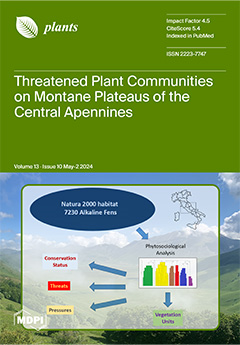Plants, Volume 13, Issue 10 (May-2 2024) – 142 articles
In Europe, alkaline fens attributable to the order Caricetalia davallianae Br.–Bl. 1949 and protected 7230 EEC Habitat are primarily distributed in cold and cool temperate climates, while they become rare in southern areas where Mediterranean influences prevail. They are considered very threatened in Central and Southern Italy, and some of them have disappeared in recent decades, as is the case regarding the Colfiorito swamp, where a LIFE project is underway with the goal of restoring part of it.
This vegetation, on the plateaus of the Central Apennines, is generally linked to small springs. Extensive grazing and hay harvesting are practiced there, while agricultural exploitation is relatively modest, contributing to the preservation of these fragments of vegetation. View this paper
- Issues are regarded as officially published after their release is announced to the table of contents alert mailing list.
- You may sign up for e-mail alerts to receive table of contents of newly released issues.
- PDF is the official format for papers published in both, html and pdf forms. To view the papers in pdf format, click on the "PDF Full-text" link, and use the free Adobe Reader to open them.






